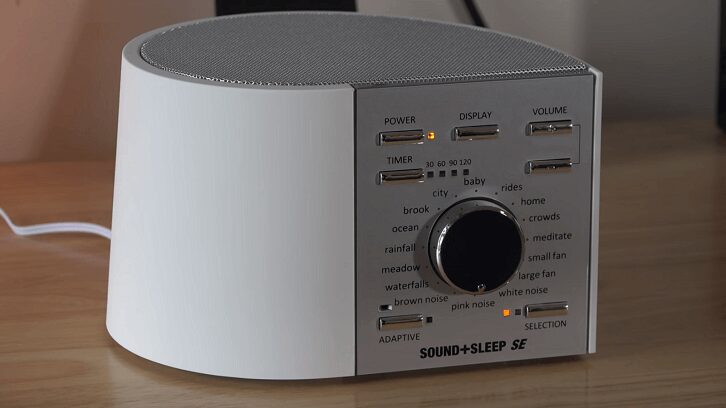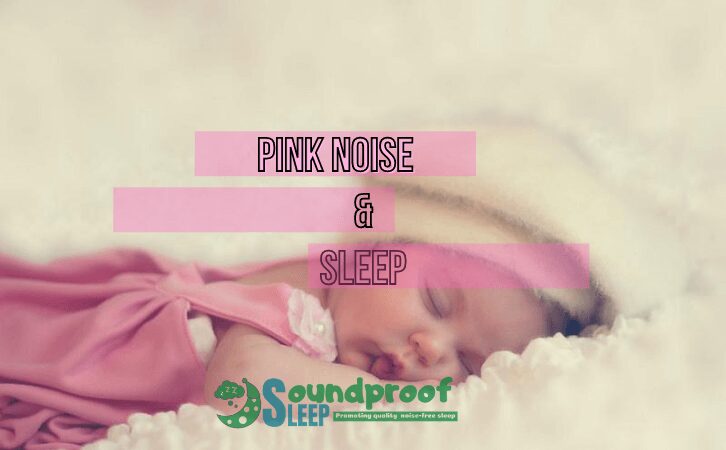You might be familiar with white noise or white noise machines. White noise, which sounds like radio or TV static, has long been used to mask other sounds when sleeping or relaxing. Pink noise is growing in popularity within the struggling-to-sleep community. Like white noise, pink noise masks against other sounds and also has a relaxing effect on the body. Is pink noise better than white noise?
[sta_anchor id=”what-is-pink-noise”]What is Pink Noise?[/sta_anchor]
Pink noise is a combination of all sounds or frequencies of sound that a human ear can hear in the range of 20 Hz to 20000 Hz. However, unlike white noise, with pink noise, the power per hertz decreases as the frequency increases. This means the lower frequencies in pink noise have more energy, which results in a deeper and more balanced sound.

Similar patterns to pink noise occur in several phenomenons. Rustling leaves, a train chugging along, rain falling on a pavement, or rainstorms, gentle ocean waves, a fan on a low setting, or sometimes rumbling traffic.
Pink noise has long been used to test and equalize loudspeakers, and recently it has gained more popularity in bedrooms to help people sleep better. However, is pink noise better than white noise?
[sta_anchor id=”pink-noise-vs-white-noise”]Pink Noise vs. White Noise[/sta_anchor]
Both pink noise and white noise can help to block out other sounds. They mask disruptive sounds, reduce the intensity of noise, which helps a person sleep or relax.
Pink noise and white noise differ because pink noise decreases the power per hertz as the frequency increases, while white noise has equal power per hertz across all its frequencies. White noise is more static sounding, but pink noise mimics the sounds of nature.
Pink noise is similar to white noise, but louder and with stronger bass.
The choice of whether to go with pink noise or white noise will come down to personal preferences. Everyone is different, and what works well for other people might sound very different to you.

Before getting a sound machine of white noise fan, first, listen to white, pink, or even brown noise tracks on Spotify or Youtube. Listening to the individual noise colors is the best way to find out which works best for you. There are also sound machines that offer both white and pink noise like the Adaptive Sound Technologies Sound+Sleep SE. We also have a detailed post of our best sound machines that include white, pink, and brown noise machines.
[sta_anchor id=”can-pink-noise-help-sleep-better”]Can Pink Noise Help You Sleep Better?[/sta_anchor]
In a 2012 study on the effect of pink noise on complexity synchronization of brain activity and sleep consolidation, Participants were divided and a part of the group exposed to pink noise when sleeping. The study concluded that pink noise had a significant effect on inducing sleep and improving the sleep quality of individuals.
In another study, researchers used pink noise to try and enhance deep sleep in older adults (60–84 years) in an attempt to improve their memory. The research concluded that the use of pink noise enhanced slow-wave activity (SWA) and improved sleep-depend memory, which strengthened sleep and improved memory in older adults.
So far, not much research has been documented on pink noise. However, the results seem to be positive. Pink noise can help you get better quality sleep or induce sleep. Improved memory has also been associated with pink noise in different studies.
Wrapping Up
Because there have been no studies comparing pink noise to white, or brown noise, I cannot tell which color is best for sleeping. Like I pointed out before, it is good to try all of them and decide which works well for you. If Pink noise is not for you, then you have white or brown.
Have you tried using background noise to sleep? Which noise color do you prefer, and why? Comment below, and let’s continue this conversation.

